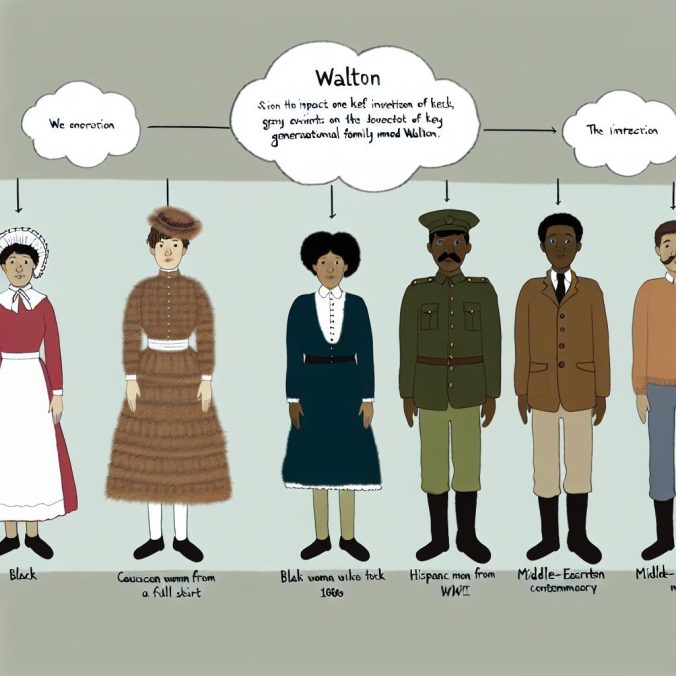The Walton Family: Origins and Growth
The Walton family, known worldwide for establishing Walmart, a leading giant in the global retail industry, has a remarkable history that intertwines with significant historical events that have profoundly shaped their business strategies and success. This journey began with Sam Walton, whose vision and leadership set the foundation for what would become the world’s largest retail corporation. The inception of Walmart in 1962 came at a pivotal moment in American history, marked by substantial economic and cultural transformations that influenced not only the Walton family but also the retail landscape in the United States.
The Great Depression: Setting the Stage
The economic devastation of the Great Depression had far-reaching impacts on millions of Americans, including the young Sam Walton. Growing up in such a challenging era instilled crucial principles that guided Walton’s business philosophy. The economic hardships necessitated a focus on frugality and maximization of value. These lessons in thrift and resourcefulness translated directly into Walton’s business model, which emphasized low prices and cost efficiency. This strategy not only resonated with customers looking for affordability but also structured Walmart’s approach to scale up effectively. Walton’s understanding of the importance of affordability was a cornerstone of Walmart’s business ethos, driving the establishment of a retail empire that prioritized the economic realities of average consumers.
Post-World War II Economic Boom
The conclusion of World War II ushered in a period of unprecedented economic prosperity in the United States. Known as the “Golden Age of Capitalism,” this era was characterized by strong economic growth, increased consumer spending, and significant advancements in manufacturing and technology. For entrepreneurs like Sam Walton, it was a time ripe with opportunities. The post-war economic conditions allowed for business expansion and innovation, key aspects that Walton adeptly capitalized on. He focused on opening stores in rural America, locations that were often overlooked by other retailers. This strategic positioning not only tapped into an underserved market but also took advantage of the burgeoning supply chain technologies of the era. Walton’s ability to harness the economic boom drove Walmart’s growth across the nation, setting the stage for its future expansion.
The Civil Rights Movement and Integration
The 1960s and 1970s were transformative decades in American history, largely shaped by the Civil Rights Movement. This period presented both challenges and opportunities for American businesses, including Walmart. As societal norms shifted towards equality and integration, businesses faced new legal and social expectations. Walmart, under the leadership of the Walton family, responded by implementing non-discriminatory employment practices, which were aligned with the broader movement toward equality. By committing to integrative policies, Walmart not only complied with legal standards but also expanded its workforce diversity. These actions helped broaden their customer base as they became more reflective of the communities they served. The commitment to integration was more than compliance; it represented a strategic adaptation to the social changes that ultimately supported Walmart’s long-term growth and community acceptance.
The Digital Revolution
The latter part of the 20th century and the early decades of the 21st century marked the beginning of the digital revolution, which presented both challenges and opportunities for the retail industry. Traditional retail models were disrupted by digital technology, compelling the Walton family to adapt swiftly to maintain Walmart’s standing in the competitive retail sector. Recognizing the importance of technological integration, Walmart made significant investments in e-commerce and advanced technologies. These investments included developing an online shopping platform that complemented their physical stores, ensuring customer access to their products anytime and anywhere. They also adopted digital payment systems, which streamlined transactions and improved customer convenience. By embracing digital transformation, the Walton family ensured that Walmart would not only remain competitive but also thrive in the evolving retail environment.
The Walton family’s journey reflects a multifaceted legacy of adaptation and resilience in the face of historical changes. Their ability to navigate these challenges and seize opportunities provides valuable insights into how historical events can shape business strategies and success. The Walton’s story is a testament to the enduring importance of adaptability in business and personal endeavors, offering lessons that remain relevant in today’s dynamic global marketplace. For additional details about the Walton family and their impact on the retail industry, visit their official website at Walmart Corporate.


